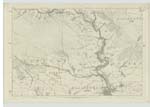OS1/25/42/13
| List of names as written | Various modes of spelling | Authorities for spelling | Situation | Description remarks |
|---|---|---|---|---|
| Supposed Site of the BATTLE OF MONS GRAMPIUS (Continued) | 052 | [continued from page 12] It will therefore be unnecessary for us to enter into, even a brief summary of the various operation therin detailed. You must have remarked, however, that from the account of Tacitus, little or nothing can be gathered by which the locality of the decisive engagement may be determined. In fact, all the information it affords us on this point is contained in the single statement that it was fought "ad montem Grampium" which is rendered by Murphy the "Grampian Hills", it being common with the Romans to express a mountain range in the singular number as for example, Mons Oscelum, the Ochils. If Tacitus meant to distinguish any single mountain by the appelation of Mons Grampius, we are left entirely to conjecture as to the particular one so honoured, for the name is now unknown in any such limited application. Accordingly antiquaries have not conceived themselves at all hampered in their theories and speculations by any necessity of placing the site of the battle near the Grampian hills. Some and among them Chalmer's in his Caledonia hold the Muir of Orchill, in the vicinity of the Roman Camp at Ardoch, to be the scene of this battle: But there are no vestiges of a great battle to be found there. Gordon in his Itinerorium Septentrionale, contends for Dealgin Ross, near Comrie; but the works there are only capable of containing somewhere about 10.000 men, while Agricola's Army amounted to 26000: and besides, this antiquary was ignorant of the Camps & other antiquities of Strathmore. The Revd. [Reverend] Mr. Small in a work on Roman Antiquities (published 1823) proves to his own entire & perfect satisfaction, the battle in question was fought near Strathmiglo, in the west of Fife, at a place called Meralsford; & the Revd. [Reverend] Gentleman describes the whole affair with all the minuteness of a modern dispatch But the West Lomond is not Mons Grampius, nor one of the Grampians; and he has omitted to point out where the Romans were encamped, and mentions only certain entrenchments, which according to to the dimensions given, would not contain a single cohort. Another Antiquary (Colonel Miller F.R.S. [Fellow of the Royal Society] London) while he also considers Meralsford as the scene of the battle, differs entirely from Mr. Small, as to the occupied by the two armies respectively, and also to the progress of the contest. To reconcile his account with that of Tacitus, he calls the Lomonds Mons Grampius; Wherever the great battle took place, we feel thoroughly convinced it was not in the precincts of the "Kingdom of Fife". Galgacus probably had not much military skill, but it is not very likely he would be foolish enough to leave the strong ground north of the Tay and lead 30000 men into such a Cul de Sac as Fife, where there was so much risk of his retreat being cut off in the event of a defeat. - A great battle undoubtedly has been fought at Meralsford, but it was probably with the Danes, not the Romans. Tradition at least says so, and many local names confirm the hypothesis. Having thus put aside all opposing hypothesis, we have some room for exhibiting our own, which we hope to convince you, is the only feasible one Viz: that the decisive engagement between Agricola and Galgacus was actually fought in this very district of the Stormont, and in the immediate vicinity of Craig Roman on which we are now standing, previously laying before you the grounds of this conclusion, we beg to assure you that we have no wish to lay claim to originality on behalf of our theory. It is no new conjecture, but has been long ago maintained by divers antiquaries and has very recently been argued at length, with considerable ability by Mr. Knox in his "Topography of the Basin of the Tay". We have already said that the point is necessarily unsusceptible of anything like absolute proof. All that can be expected therefore, is, that we shall be able to shew a greater array of circumstances in support of our views, than has been exhibited in connection with any of the other localities we have alluded to. In the first place, then, we have a distinct and unvarying tradition prevailing over the whole district of Stormont, to the effect that a great battle was fought in the vicinity of Blairgowrie, between the Caledonians and Romans, in which the latter were victorious, this is something. Next we have in confirmation of this tradition, a whole host of local names. - Stormont itself is a name of warlike import; Stour in runic Stour, Saxon, both signifying a battle, "and Stourment means the Main battle", Blair in Gaelic also signifying battle - And we have several places, the names of which have this word as a prefix or component part, for example Blairgowrie, Ardblair, the height of the battle, close at the foot of Craig Roman, Little Blair, Loch Blair &c But we must find a Camp for the Roman Army: - Nothing more easy, at Meiklour about 4 miles to the south of Craig Roman, in the angle formed by the confluence of the Isla and the Tay, are clearly to be seen the remains of a Roman Camp, capable of containing the Army of Agricola protected by the two rivers in question on two sides of the triangular encampment, it was only necessary to throw up an intrenchment in front. towards [continued on page 14] |
Continued entries/extra info
[Page] 13Transcribers who have contributed to this page.
Alison James- Moderator, Brenda Pollock
Location information for this page.
Linked mapsheets.




